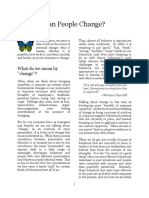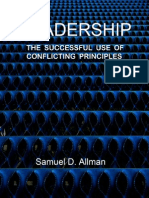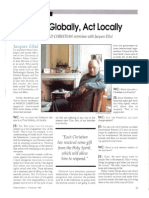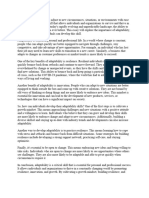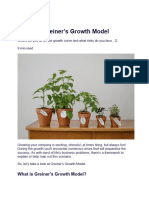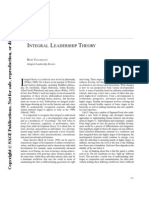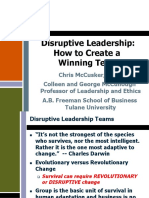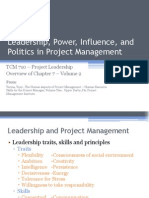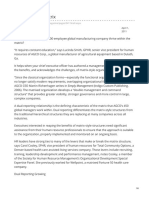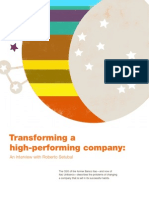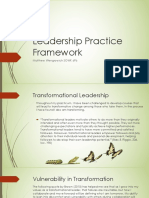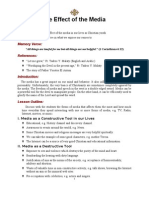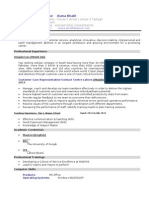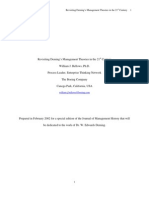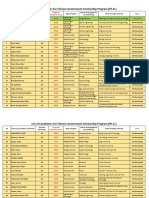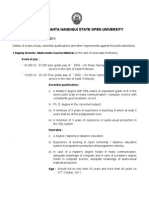Antonio Damasio: A M P M
Antonio Damasio: A M P M
Uploaded by
asdefenceCopyright:
Available Formats
Antonio Damasio: A M P M
Antonio Damasio: A M P M
Uploaded by
asdefenceOriginal Description:
Original Title
Copyright
Available Formats
Share this document
Did you find this document useful?
Is this content inappropriate?
Copyright:
Available Formats
Antonio Damasio: A M P M
Antonio Damasio: A M P M
Uploaded by
asdefenceCopyright:
Available Formats
Introduction
For us in the beginning it was being, and only later it was thinking. First, we are, and then we think, and we think only inasmuch as we are, since thinking is indeed caused by the structures and operations of being.
Antonio Damasio One of the largest financial institutions in North America recently took on a large-scale, organization-wide change program. At the outset, each of its independently operating business units had its own human resource (HR) functions. The aim of the program was to shift HR from this decentralized, distributed system to a centralized operation offering fee-for-service to the units. The enterprise had retained a prominent consultant (one who had truly earned the honorific of guru) who was pioneering new approaches in the field of change management. As part of the firms heavy investment in preparing for the change, the consultant worked closely with executives and the firms entire HR community. A series of small- and large-group interventions had been held in order to train-up the departments and their constituents in the theory and practice of the change they were about to make. Planning and preparation were thorough and exhaustive. Senior management prepared operational systems and had secured the buy-in of subsidiary business units. A centralized, shared-services operation was ready to swing into action. On a Monday morning at 8:00 A.M. the company threw the switch, and the new shared-services system went operational. On Friday at 5:00 P.M. the change program was cancelled, the senior vice presidents who had sponsored the program resigned, and the organization development staff representing the changes in the business units were about to be sacked. Shortly after, the HR consultant held an evening speaking session at a local hotel. He was featuring his models and, in that context, was considering the failed attempt at change in this organization. During the Q&A following his remarks, we asked him, "When you plan a major change program, do you ever consider how that change fits with the culture current in the enterprise? He stopped, looked up at the ceiling for what seemed an interminably long time, and finally looked us straight in the eye. No, he answered. We appreciated his stark honesty. We suspected strongly that a problem of the culture of leadership lay behind the failure. But we were equally sure this well-respected consultant was and is not alone in ignoring the role of culture in organizational change. Change management practices have been carefully designed and analyzed for decades by company leaders and their advisers, but few
of them, even today, consider the power of culture, especially the organizations leadership culture, to affect and even derail enterprise-wide change efforts. The field of organizational development, spawned over forty years ago, has developed practices in change management that regularly fail to achieve any significant results. Since the 1990s, as many as three-quarters of organizational change efforts have failed. Studies suggest that organization-wide failure rates range from 66 to 75 percent, and one study revealed that only one-third of organization-wide change initiatives achieve any success at all (Beer, 2001). It is no wonder that executives are jaded about making big investments in organization change programs. These change management programs are primarily focused on external systems, structures, and processes. In their recent review of the organizational development field, Bradford and Burke (2005) indicate that some say we are witnessing the final demise of this ailing discipline. We see it differently -- not as a setting sun but as a new dawn, an advent of a new approach to organizational change through developing leadership culture. Understanding and tapping the power of leadership culture triggers a nearly unstoppable vigor in the spirit of human systems. Agility, speed, execution, unification, readiness --all the things that CEOs dream about -- are available to leaders willing to transform their organizations leadership culture toward interdependence. Granted, it is rare to find approaches to organizational change that focus on and work through leadership. And, more precisely, it is exceptional to find change initiatives focused through the development of senior leaders themselves. We believe this is the new trajectory of successful organizational change. Consider what you have heard or read about traditional change management pathways, and ask yourself this question: Even if I aligned all the management systems and structures in this organization toward a specific mission and bolstered it with vision, is this organizations leadership capable of facing the next uncertain future with all of its endlessly unfolding requirements for new systems and structures and process changes? If you answer no or are unsure, then we pose this challenge: perhaps the change you need is in your organizations leadership mind-set, not just in its systems and structures. We suggest that the field of leadership development is emerging as a new agent through which to achieve sustainable organizational development. Granted, challenging executives mind-sets and inviting their developmental requirements as a core means to organizational change doesnt have the history of forty years of organizational development. Neither does it have the history of 75 percent failure rates. And if our experience and work with several organizations that have attempted deep, sustainable change is any measure (and we believe it is), then organizational change through leadership culture change is not doomed to repeat that history. In this book, and in our work in general at the Center for Creative Leadership, we are redefining the field of leader development beyond individuals to embrace the leadership development of collectives that together set direction,
get alignment, and commit to imperative change results. Imagine the power of leadership as a unified force for adaptable, sustainable, organizational change, and you can see why we say, Change the leadership culture, and you change the organizational culture.
What If
This orientation answers the endless operational challenges of organizational viability and unleashes the leadership imagination: What if we acknowledged that all operational systems find their source in human systems? What if organizations are human systems first, and they manifest human ideas in operational systems? What if those human systems are carried forward through leadership culture? What if senior leaders were willing to rise above the complacency of success and the insecurity of uncertain futures to find the maturity to lead together?
Edgar Schein (1992) writes that leading the culture is what leadership does, and that makes the human system pretty much the sole territory of leadership. Developing the values and advancing the beliefs of the way that people make decisions and operate in an organization is ultimately the most powerful operating system the organization possesses. And yet it appears that even Schein does not believe in the possibility of transforming a culture. We do, and we have hard evidence to justify our belief.
Losing Control
Since the twentieth century, there have been only two basic kinds of organization and leadership cultures in the West. The first is command and control, with its roots in Frederick Turners management principles and the military-born experience of World War II. Our postindustrial era in the West lives with this hangover of hierarchy. It seems that collectively, we still need heroes and we depend on them when the heat is on. We defer our power, and we expect the individual leader to command and lead followers as the primary way to achieve goals. The imperative is to get control and to conform. The second, emergent, breakout organizational alternative that in the 1950s began to poke through the encrusted command-and-control cocoon is the achievement-based organization. W. Edwards Demings early influence continues in the lean manufacturing of Toyota, and the innovation cultures exemplified in Apple and Google. These continuous-improvement organizations hold 3
independent thought and action as core beliefs and principles. Advancing beyond the hero-led mind-set of command and control, a cluster of heroes can cooperate and coordinate activities and wintogetherwhen direction is aligned. The imperative is to get competitive and achieve. We are now perched on the threshold of a new world order that continues to unfold. At this writing, for example, the price of oil and its effect on the global supply chain may challenge some of the most basic assumptions about flat worlds, fluid labor, and free capital. Businesses challenges today barely resemble those of thirty years ago. The technical education many of us received is already failing us. We must either face up to a serious shift in our identities or continue to perish professionally and organizationally at alarming rates. In response to these unfolding consequences, a new kind of organization can be imagined. And to judge from the results of our work, it is already emerging: the interdependent-collaborative organization. Every CEO wants fast, capable response to the challenge of change. Faster, better, cheaper is impossible without collective leadership capability to reframe dilemmas, reinterpret options, and reform operationscontinuously. Cross-boundary, horizontal, customercentric value chains are not just the currently demanded reality that executives face; they are the harbingers of transformation. Institutions, organizations, and governments are going to need this adaptive, quick-footed, see-around-the-corner capacity. The imperative is collaboration and transform. Not everyone is ready to collaborate. A key purpose of this book is to assist leaders in understanding the pathway to get to the collaborative, transformative organization. For many of them, moving from the command-andcontrol mind-set into the achiever space is the necessary next step. We want to help you imagine and implement a readiness pathway that makes change feasible for you and your organization. Leadership culture can be cement walls with steel ceilings that are always in your way, or leadership culture can generate and expand into a unified force for a promising, innovative, and sustaining future.
Three Things in This Book You Wont Find Elsewhere
What is really new and different in our method of change? For one, the way we approach clients with a balance of discovery, challenge, and support has freshness. Our combinations of intervention content and the integration of developmental theory within our research-based tools that measure collective mind-sets are assuredly new, if not unique. But what is really new and different and reflected in this book are three things. First, executives do the change work first. Executives cant delegate culture transformation work to others. Not anymore. Without first wading into the
cultural morass of internal beliefs themselves, and then making common sense of it in dialogue with others, executives and senior leaders have an extremely poor chance (the odds are one in three or four) of achieving successful organizational transformation. We insist that executives involve more than themselves in the change process. We are adamant that they lead by engagement and example. We follow two simple principles: (1) Do not ask others to do what you are not willing to do yourself. (2) If you want something different, then become something different. Second, a critical mass of the leadership culture becomes the change and takes change to the middle. Serious people connected together in change leadership commit to the mutual risk of collectively initiating new leadership beliefs and practices that generate change. Developing leadership to the next level of maturity while implementing strategic imperatives is the glue of change. It bonds a critical mass of senior leaders to demonstrate alignment toward the change they expect of others by discovering and navigating a joint future together. Then a solid coalition of connected leadership shows up and stands up to advance this increasingly clearer organizational direction into the organizational middle. Together, senior leaders engage both nominal and potential leaders in generating new leadership beliefs and practices that create new aligning mechanisms that advance strategic intent and goals. The viral momentum of seeing is believing spurs movements. Third, everyone gets bigger minds. If not unique, our practice is unusual in its dedication to the advancement of higher orders of human potential in organizations. We stand on a platform of advancement toward more interdependent, collaborative leadership cultures, their beliefs and practices, and the organizations they are intended to serve. This platform orients organizations toward a connected, collective leadership capability in which everyone in the organization can share. From this support, leaders individually and leadership collectively can shake loose from the complacency of individual success and elevated organizational position to deal with the reality of telling the truth, finding deeper wisdom in the way things really are, and accepting accountability for the sustainability of the whole organization. Understanding and facing that new situation requires increasingly more complex and bigger minds that are willing and capable of dealing with the increasing complexity of an ever-changing world. The willingness to learn is the only requirement to getting a bigger mind.
Whom This Book Is For
Connected human potential is endless. As human beings we want and need to drive and thrive to the next level, the next potential, the next fulfillment. It is our nature. Even so, this book addresses first and foremost executives and organizational leaders of all kinds who see that change is necessary but have
become skeptical that lasting, sustainable changetransformationlies beyond their reach. We think that when you believe that leadership culture is in you and that leadership can be a boundless, emergent, imagining creative force for change, you can construct endless new orders of human and operational potential that transcend boundaries and are limited only by your willingness and then your ability to realize them. We have seen and heard and felt and experienced this potential in leaders and organizations willing to believe in the possibilities of their spirit and determination. Are you ready?
You might also like
- 0520 Scheme of Work (For Examination From 2021)Document64 pages0520 Scheme of Work (For Examination From 2021)Sheila Ester Nyange100% (1)
- Inclusive Leadership From Awareness To ActionDocument33 pagesInclusive Leadership From Awareness To Actionsdas123No ratings yet
- Case Analysis. John Meredith of Hutchison Port HoldingsDocument2 pagesCase Analysis. John Meredith of Hutchison Port HoldingsMohamad MaibarNo ratings yet
- Strategic Analysis of TescoDocument21 pagesStrategic Analysis of Tescosadiachaudhary80% (5)
- Corporate Reputation: Meaning and Measurement: Rosa ChunDocument19 pagesCorporate Reputation: Meaning and Measurement: Rosa Chunshumon2657100% (1)
- WSDE PresentationDocument10 pagesWSDE PresentationChloe SNo ratings yet
- Can People Change? - Bradford and HuckabayDocument4 pagesCan People Change? - Bradford and HuckabaysiriNo ratings yet
- Developing LeadersDocument42 pagesDeveloping LeadersMichael WeemsNo ratings yet
- Developing Leaders at Southwest AirlinesDocument7 pagesDeveloping Leaders at Southwest Airlinesapi-307132738No ratings yet
- David Jackson Article Head Heart Guts Anatomy of A Whole LeaderDocument12 pagesDavid Jackson Article Head Heart Guts Anatomy of A Whole LeaderSunita Bhanu PrakashNo ratings yet
- .Leadership The Successful Use of Conflicting Principles PDFDocument34 pages.Leadership The Successful Use of Conflicting Principles PDFChanakaLakmalHewageNo ratings yet
- Chapter 9: Authentic LeadershipDocument18 pagesChapter 9: Authentic LeadershipMelvin ShajiNo ratings yet
- Bridging Space Over Time - Global Virtual Team Dynamics and EffectDocument20 pagesBridging Space Over Time - Global Virtual Team Dynamics and EffectKrishna JhaNo ratings yet
- SemcoDocument29 pagesSemcocompangelNo ratings yet
- Think Globally Act LocallyDocument5 pagesThink Globally Act LocallyasdefenceNo ratings yet
- Think Globally Act LocallyDocument5 pagesThink Globally Act LocallyasdefenceNo ratings yet
- GUIDE TO BECOMING AN EFFECTIVE MANAGER: Thoughts For ConsiderationFrom EverandGUIDE TO BECOMING AN EFFECTIVE MANAGER: Thoughts For ConsiderationNo ratings yet
- Transformation and Levels of Work - CRF BreakfastDocument8 pagesTransformation and Levels of Work - CRF BreakfastStanley ArumugamNo ratings yet
- Adaptability and ResilienceDocument5 pagesAdaptability and ResilienceDimas Hafidz Putra Yesa0620No ratings yet
- Williams Rhonda Zol ResumeDocument2 pagesWilliams Rhonda Zol Resumeapi-240696268No ratings yet
- Likert's Management SystemDocument1 pageLikert's Management SystemMalay EbajoNo ratings yet
- Primal Leadership - The Hidden Driver of Great PerformanceDocument3 pagesPrimal Leadership - The Hidden Driver of Great PerformanceRiyoHussainMNo ratings yet
- GUIDES To Grenier ModelDocument7 pagesGUIDES To Grenier ModelAyesha SiddiquaNo ratings yet
- Finding The Right Balance - and Flexibility - in Your Leadership StyleDocument5 pagesFinding The Right Balance - and Flexibility - in Your Leadership StyleAtiq uRehmanNo ratings yet
- Volkmann - Integral LeadershipDocument7 pagesVolkmann - Integral Leadershipcaras gachasNo ratings yet
- AccountabilityDocument4 pagesAccountabilityNaveen Kishore GattimNo ratings yet
- Change and Thrive: A Modern Approach to Change LeadershipFrom EverandChange and Thrive: A Modern Approach to Change LeadershipNo ratings yet
- Literature ReviewDocument41 pagesLiterature ReviewMunguongeyo Ivan100% (1)
- Disruptive LeadershipDocument36 pagesDisruptive LeadershipJagannadha GantiNo ratings yet
- Internal Consultants As Agents of Change: Research ReportDocument32 pagesInternal Consultants As Agents of Change: Research ReportNaisonGaravandaNo ratings yet
- TCM 710 - Volume 2 Chapter 7 Leadership, Power, Influence and Politics in PMDocument10 pagesTCM 710 - Volume 2 Chapter 7 Leadership, Power, Influence and Politics in PMsintg3No ratings yet
- The Future of Leadership For Conscious Capitalism: Barrett C. Brown, Ph.D. - Metaintegral AssociatesDocument24 pagesThe Future of Leadership For Conscious Capitalism: Barrett C. Brown, Ph.D. - Metaintegral AssociatesjohnNo ratings yet
- Leading and Managing Teams PPT, Task-2Document14 pagesLeading and Managing Teams PPT, Task-2Joanna100% (1)
- Developing High Performance TeamsDocument6 pagesDeveloping High Performance TeamsCinan SatharNo ratings yet
- Leadership Development Plan BillyandriDocument11 pagesLeadership Development Plan BillyandriBillie Yandri FirsaNo ratings yet
- The Future Arrived Yesterday, by Michael S. Malone - ExcerptDocument45 pagesThe Future Arrived Yesterday, by Michael S. Malone - ExcerptCrown Publishing Group100% (1)
- Problem Solving TeamsDocument3 pagesProblem Solving TeamsUbaid0% (1)
- Literature Review On Spiritual LeadershipDocument9 pagesLiterature Review On Spiritual LeadershipafdtwadbcNo ratings yet
- Guidebook: Developing Core Values, Beliefs, and Learning ExpectationsDocument32 pagesGuidebook: Developing Core Values, Beliefs, and Learning ExpectationsDragomir IsabellaNo ratings yet
- Leadership: Osorio - Paigan - Pantaleon - Peñaflor - Peñaflorida - Pregil - Reliquias - Rodinas - SaldoDocument92 pagesLeadership: Osorio - Paigan - Pantaleon - Peñaflor - Peñaflorida - Pregil - Reliquias - Rodinas - SaldoGlaze Rodinas100% (1)
- Disruptive Leadership - Challenging The Status Quo Through Disruptive Leadership Innovation CentralDocument2 pagesDisruptive Leadership - Challenging The Status Quo Through Disruptive Leadership Innovation Centraladedeji joshuaNo ratings yet
- Disruptive Leadership With ScrumDocument33 pagesDisruptive Leadership With Scrum陈豪No ratings yet
- Change ModelDocument35 pagesChange ModelAslam HussainNo ratings yet
- Time For CommunicationDocument2 pagesTime For CommunicationCesarMartinezNo ratings yet
- Values-Based Leadership: The Lighthouse of Leadership TheoryDocument9 pagesValues-Based Leadership: The Lighthouse of Leadership TheoryStacey CrawfordNo ratings yet
- Current Leadership Theories and MillennialsDocument2 pagesCurrent Leadership Theories and MillennialsXu Bin100% (1)
- 1 - Leadership-Power and Influence-Lecture 1-SBDocument41 pages1 - Leadership-Power and Influence-Lecture 1-SBashutosh_parida_5No ratings yet
- Ch3 ACCA BPP F1 SlideDocument25 pagesCh3 ACCA BPP F1 SlideIskandar BudionoNo ratings yet
- How To Mess Up Your Agile Transformation in Seven Easy MisstepsDocument6 pagesHow To Mess Up Your Agile Transformation in Seven Easy MisstepsPham Ba NamNo ratings yet
- I Change 2 - Change Curve V2Document13 pagesI Change 2 - Change Curve V2Ahmed NawazNo ratings yet
- Chapter 14 - Organisational CultureDocument7 pagesChapter 14 - Organisational CultureCarol YapNo ratings yet
- Mod 1 1 Concepts of Everyday LeadershipDocument26 pagesMod 1 1 Concepts of Everyday LeadershipSaifuzzaman AntorNo ratings yet
- Managing Organizational Culture and ChangeDocument24 pagesManaging Organizational Culture and ChangeMohd FitriNo ratings yet
- Managing The MatrixDocument6 pagesManaging The Matrixomgan1042No ratings yet
- Organizational ChangeDocument34 pagesOrganizational ChangeAmit KumarNo ratings yet
- 10 Ways To Operationalize Your Diversity Process: Linda H. Stokes President and CEO PRISM International IncDocument5 pages10 Ways To Operationalize Your Diversity Process: Linda H. Stokes President and CEO PRISM International IncDroplet Yaadien100% (1)
- Transforming A High Performing CompanyDocument10 pagesTransforming A High Performing Companyswapneel_gen9599100% (2)
- PMG 422 Milestone Two 1Document9 pagesPMG 422 Milestone Two 1api-660842894No ratings yet
- Internal Team Dynamics and Decision-MakingDocument5 pagesInternal Team Dynamics and Decision-Makingapi-561686395No ratings yet
- Organisational Development InterventionDocument10 pagesOrganisational Development InterventionAnusua Jana100% (1)
- Quality in The 21st CenturyDocument8 pagesQuality in The 21st CenturyMegan LeeNo ratings yet
- LXP SoR ChangeManagement-Playbook 080323 WebDocument32 pagesLXP SoR ChangeManagement-Playbook 080323 WebAhmad FaragNo ratings yet
- Leadership FrameworkDocument8 pagesLeadership Frameworkapi-311840545No ratings yet
- Corporate Culture of VWDocument2 pagesCorporate Culture of VWUsman MahmoodNo ratings yet
- Strategic Leadership Knowledge ManagementDocument14 pagesStrategic Leadership Knowledge ManagementAlthea mayNo ratings yet
- AccountingDocument14 pagesAccountingasdefence50% (2)
- 2.3.2.2 Inaccurate Time EstimateDocument1 page2.3.2.2 Inaccurate Time EstimateasdefenceNo ratings yet
- 03 Emergency Response & RecoveryDocument104 pages03 Emergency Response & RecoveryasdefenceNo ratings yet
- 03 Emergency Response & RecoveryDocument104 pages03 Emergency Response & RecoveryasdefenceNo ratings yet
- DemingDocument12 pagesDemingasdefenceNo ratings yet
- 101 Cw1 d1 - Revision 1Document16 pages101 Cw1 d1 - Revision 1asdefenceNo ratings yet
- Setting Up Accounts Receivable Policies For Business in CanadaDocument24 pagesSetting Up Accounts Receivable Policies For Business in CanadaasdefenceNo ratings yet
- Please, Some Vocabulary No Need To Change Like (Purification, SynthesisDocument6 pagesPlease, Some Vocabulary No Need To Change Like (Purification, SynthesisasdefenceNo ratings yet
- 28 Disability Support AppendixdDocument20 pages28 Disability Support AppendixdasdefenceNo ratings yet
- The Effect of The Media: ObjectiveDocument8 pagesThe Effect of The Media: ObjectiveasdefenceNo ratings yet
- Meghan Mcgowan Professor Gervais Case #3 4/2/12: Starbucks CorporationDocument13 pagesMeghan Mcgowan Professor Gervais Case #3 4/2/12: Starbucks Corporationasdefence50% (2)
- Name Asma Khalil: Address - House 2 Street 1 Phase 3 Tajbagh Lahore Mobile - 03028474692 03364596975 E-MailDocument2 pagesName Asma Khalil: Address - House 2 Street 1 Phase 3 Tajbagh Lahore Mobile - 03028474692 03364596975 E-MailasdefenceNo ratings yet
- Meghan Mcgowan Professor Gervais Case #3 4/2/12: Starbucks CorporationDocument13 pagesMeghan Mcgowan Professor Gervais Case #3 4/2/12: Starbucks Corporationasdefence50% (2)
- A Review of The Strategic Situation of KepakDocument5 pagesA Review of The Strategic Situation of KepakasdefenceNo ratings yet
- Bellows Deming 21stDocument12 pagesBellows Deming 21stasdefenceNo ratings yet
- Technolink College Studies: PostgraduateDocument49 pagesTechnolink College Studies: PostgraduateGadisa GutaNo ratings yet
- Reading 12Document9 pagesReading 12nguyentuanmieng26No ratings yet
- Peach Modern Course BrochureDocument2 pagesPeach Modern Course BrochurejeaedubalaNo ratings yet
- Ôn Thi Gi A Kì 1 - L P 12 (Chương Trình M I)Document15 pagesÔn Thi Gi A Kì 1 - L P 12 (Chương Trình M I)Nguyễn HảiNo ratings yet
- Myp Design Integration With Other Subjects enDocument45 pagesMyp Design Integration With Other Subjects enGeorge Oswald J.CarringtonNo ratings yet
- CDI Framework GuidanceinSecondarySchools.250279149Document24 pagesCDI Framework GuidanceinSecondarySchools.250279149M AmbreenNo ratings yet
- CSC PHD ListDocument70 pagesCSC PHD ListAli AzamNo ratings yet
- Krishna Kanta Handiqui State Open University: Advertisement No.R 1/2011Document8 pagesKrishna Kanta Handiqui State Open University: Advertisement No.R 1/2011Mukesh BishtNo ratings yet
- B2 UNIT 7 Culture Teacher's NotesDocument1 pageB2 UNIT 7 Culture Teacher's Notesdima khrushcevNo ratings yet
- PSBA vs. Court of AppealsDocument2 pagesPSBA vs. Court of AppealsvcruzcruisinNo ratings yet
- Values Ed - PEAC Streamlining The K 12 CurriculumDocument108 pagesValues Ed - PEAC Streamlining The K 12 CurriculumBin Abubakar100% (1)
- CVDocument6 pagesCVKhowla JhaidarNo ratings yet
- Silent Ambition PDFDocument5 pagesSilent Ambition PDFsupositionNo ratings yet
- ENG GRADE 6 WK 5 10 WS A4 SizeDocument6 pagesENG GRADE 6 WK 5 10 WS A4 SizeCatherine RenanteNo ratings yet
- Adrián Echegaray Maneiro - The Most Prestigious UniversitiesDocument7 pagesAdrián Echegaray Maneiro - The Most Prestigious UniversitiesAdrián Echegaray ManeiroNo ratings yet
- Management Consulting Edison 3Document18 pagesManagement Consulting Edison 3Divyaprakash PandaNo ratings yet
- PSCYHOLOGICAL ASSESSMENT First ActivityDocument6 pagesPSCYHOLOGICAL ASSESSMENT First ActivityAngela D.No ratings yet
- Habitat Lesson 5-OceanDocument7 pagesHabitat Lesson 5-Oceanapi-270058879No ratings yet
- Effect of Gender On Students' Academic Performance and Retention in Financial Accounting in Technical CollegesDocument9 pagesEffect of Gender On Students' Academic Performance and Retention in Financial Accounting in Technical CollegesMary Amor Moralda ReyesNo ratings yet
- Tefl Assignment 4Document3 pagesTefl Assignment 4samazha.naidoo07No ratings yet
- Labor Law 1 Bar Q A Part 2 2007 2015Document40 pagesLabor Law 1 Bar Q A Part 2 2007 2015Anonymous bOncqbp8yiNo ratings yet
- The Technical University of Kenya 2020 Kuccps Placed StudentsDocument56 pagesThe Technical University of Kenya 2020 Kuccps Placed Studentslixus mwangi100% (1)
- Social Studies Lesson Plan Globes and Maps Final SCDocument8 pagesSocial Studies Lesson Plan Globes and Maps Final SCapi-457032696No ratings yet
- The Vanderbilt Chemistry Majors HandbookDocument6 pagesThe Vanderbilt Chemistry Majors HandbookareacepatNo ratings yet
- Nicolae Testemi Țanu Biography: Student: Rotarciuc JanaDocument14 pagesNicolae Testemi Țanu Biography: Student: Rotarciuc JanaNatalia CaramanNo ratings yet
- The BEST Muliko - Factors Affecting Technology Adoption by SMES Automobile Garages in Nairobi CountyDocument48 pagesThe BEST Muliko - Factors Affecting Technology Adoption by SMES Automobile Garages in Nairobi CountytemesgenNo ratings yet
- Project Management - IntroductionDocument30 pagesProject Management - Introductionshahejad007No ratings yet
- Parent March On Washington Speaker Agenda May 1-3, 2019Document2 pagesParent March On Washington Speaker Agenda May 1-3, 2019Leon R. KoziolNo ratings yet






